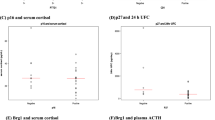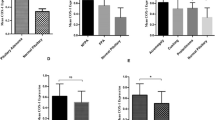Abstract
Subclinical Cushing’s disease (SCD) is characterized by lack of clinically evident Cushingoid features, despite abnormal hypersecretion of ACTH. Nearly half the cases of SCD are due to macroadenomas, and in the majority of them, ACTH secretion is not inhibited even by high-dose dexamethasone. Impaired glucocorticoid (GC) action may be correlated with the proliferation and development of pituitary macroadenomas causing SCD. In this study, immunohistochemical analysis of the resected tumors were performed to evaluate the expression of 11β-hydroxysteroid dehydrogenase type 2 (11βHSD2) and glucocorticoid receptor (GR) in pituitary tissues obtained from two SCD (macroadenomas), eight Cushing’s disease (CD) (microadenomas), nine acromegaly, and nine normal pituitary (NP). Scattered 11βHSD2-immunopositive cells were detected in all NP tissues, but its immunoreactivity was totally absent in any tumorous tissues except two CD. Scattered GR-immunopositive cells were also detected and GR immunostaining was restricted to the cytosol in NP tissue. In contrast, GR-immunopositive cells were abundantly present and GR immunostaining was restricted to the nucleus in all the tumorous tissues. There were marked differences in both expression levels and localization between NP tissues and all the tumors. There may be a mechanism other than that via 11βHSD2 for causes of impaired negative feedback action by GC in SCD and CD, but results of our present study suggest that impaired GC action may be involved, at least in part, in tumorigenesis of SCD and CD.







Similar content being viewed by others
References
Dahia PL, Grossman AB. The molecular pathogenesis of corticotroph tumors. Endocr Rev. 20:136–55, 1999. doi:10.1210/er.20.2.136.
Lamberts SWJ. Glucocrticoid receptors and Cushing’s disease. Mol Cell Endocrinol. 197:69–72, 2002. doi:10.1016/S0303-7207(02)00280-0.
Drouin J, Charron J, Gagner JP, Jeannotte L, Nemer M, Plante RK, Wrange O. Pro-opiomelanocortin gene: a model for negative regulation of transcription by glucocorticoids. J Cell Biochem. 35:293–304, 1987. doi:10.1002/jcb.240350404.
Drouin J, Bilodeau S, Vallette S. Of old and new diseases: genetics of pituitary ACTH excess (Cushing) and deficiency. Clin Genet. 72:175–82, 2007. doi:10.1111/j.1399-0004.2007.00877.x.
Ruiz M, Lind U, Gafvels M, Eggertsen G, Carlstedt-Duke J, Nilsson L, Holtmann M, Stierna P, Wilkstrom A, Werner S. Characterization of two novel mutations in the glucocrticoid receptor gene in patients with primary cortisol resistance. Clin Endocrinol. 55:363–71, 2001. doi:10.1046/j.1365-2265.2001.01323.x.
Karl M, Lamberts SW, Koper JW, Katz DA, Huizenga NE, Kino T, Haddad BR, Hudhes MR, Chrousos GP. Cushing’s disease preceded by generalized glucocorticoid resistance: clinical consequence of a novel, dominant-negative glucocorticoid receptor mutation. Proc Assoc Am Physicians 108:296–307, 1996.
Karl M, Wichert GV, Kempter E, Katz DA, Reincke M, Monig H, Ali IU, Stratakis CA, Oldfield EH, Chrousos GP, Schulte HM. Nelson’s syndrome associated with a somatic frame shift mutation in the glucocorticoid receptor gene. J Clin Endocrinol Metab. 81:124–9, 1996. doi:10.1210/jc.81.1.124.
Assie G, Bahurel H, Coste J, Silvera S, Kujas M, Dugue MA, Karray F, Dousset B, Bertherat J, Legmann P, Bertagna X. Corticotroph tumor progression after adrenalectomy in Cushing’s disease: a reappraisal of Nelson’s syndrome. J Clin Endocrinol Metab. 92:172–9, 2007. doi:10.1210/jc.2006-1328.
Woods MD, Shipston MJ, Mullens EL, Antoni FA. Pituitary corticotrope tumor (AtT20) cells as a model system for the study of early inhibition by glucocorticoids. Endocrinology. 131:2873–80, 1992. doi:10.1210/en.131.6.2873.
Katznelson L, Bogan JS, Trob JR, Schoenfeld DA, Hedley-Whyte ET, Hsu DW, Zervas NT, Swearingen B, Sleeper M, Klibanski A. Biochemical assessment of Cushing’s disease in patients with corticotroph macroadenomas. J Clin Endocrinol Metab. 83:1619–23, 1998. doi:10.1210/jc.83.5.1619.
Korbonits M, Bujalska I, Shimojo M, Nobes J, Jordan S, Grossman AB, Stewart PM. Expression of 11 beta-hydroxysteroid dehydrogenase isoenzymes in the human pituitary: induction of the type 2 enzyme in corticotropinomas and other pituitary tumors. J Clin Endocrinol Metab. 86:2728–33, 2001. doi:10.1210/jc.86.6.2728.
Rabbitt EH, Ayuk J, Boelaert K, Sheppard MC, Hewison M, Stewart PM, Gittoes NJ. Abnormal expression of 11 beta-hydroxysteroid dehydrogenase type 2 in human pituitary adenomas: a prereceptor determinant of pituitary cell proliferation. Oncogene. 22:1663–7, 2003. doi:10.1038/sj.onc.1206293.
Draper N, Stewart PM. 11 β-hydroxysteroid dehydrogenase and the pre-receptor regulation of corticosteroid hormone action. J Endocrinol. 186:251–71, 2005. doi:10.1677/joe.1.06019.
Nigawara T, Iwasaki Y, Asai M, Yoshida M, Kambayashi M, Sashinami H, Hashimoto K, Suda T. Inhibition of 11beta-hydroxysteroid dehydrogenase eliminates impaired glucocorticoid suppression and induces apoptosis in corticotroph tumor cells. Endocrinology. 147:769–72, 2006. doi:10.1210/en.2005-0544.
Takao T, Mimoto T, Yamamoto M, Hshimoto K. Preclinical Cushing’s disease. Arch Intern Med. 161:892–3, 2001. doi:10.1001/archinte.161.6.892.
Nagai T, Imamura M, Misumi S, Mori M. Subclinical Cushing’s disease accompanied by malignant hypertension and diabetes mellitus. Intern Med. 41:566–70, 2002. doi:10.2169/internalmedicine.41.566.
Kageyama K, Moriyama T, Sakihara S, Kawashima S, Suda T. A case of preclinical Cushing’s disease, accompanied with thyroid papillary carcinoma and adrenal incidentaloma. Endocr J. 50:325–31, 2003. doi:10.1507/endocrj.50.325.
Cannavo S, Almoto B, Asta CD, Corsello S, Lovicu RM, Menis ED, Trimarchi F, Ambrosi B. Long-term results of treatment in patients with ACTH-secreting pituitary macroadenomas. Eur J Endocrinol. 149:195–200, 2003. doi:10.1530/eje.0.1490195.
Woo YS, Ishidori AM, Wat WZ, Kaltsas GA, Afshar F, Sabin I, Jenkins PJ, Monson JP, Besser GM, Grossman AB. Clinical and biochemical characteristics of adrenocorticotropin-secreting macroadenomas. J Clin Endocrinol Metab. 90:4963–9, 2005. doi:10.1210/jc.2005-0070.
Kooistra HS, Voorhout G, Mol JA, Rijinberk A. Correlation between impairment of glucocorticoid feedback and the size of the pituitary gland in dogs with pituitary-dependent hyperadrenocorticism. J Endocrinol. 152:387–94, 1997. doi:10.1677/joe.0.1520387.
Bosje JT, Rijinberk A, Mol JA, Voorhout G, Kooistra HS. Plasma concentration of ACTH precursors correlate with pituitary size and resistance to dexamethasone in dogs with pituitary-dependent hyperadrenocorticism. Domest Anim Endocrinol. 22:201–10, 2002. doi:10.1016/S0739-7240(02)00128-5.
Suzuki T, Sasano H, Suzuki S, Hirasawa G, Takeyama J, Muramatsu Y, Date F, Nagura H, Krozowski ZS. 11 β-Hydroxysteroid dehydrogenase type 2 in human lung: possible regulator of mineralocorticoid action. J Clin Endocrinol Metab. 83:4022–5, 1998. doi:10.1210/jc.83.11.4022.
Krozowski ZS, Maguire JA, Stein-Oakley AN, Dowling J, Smith RE, Andrews RK. Immunohistochemical localization of the 11β-hydroxysteroid dehydrogenase type II enzyme in human kidney and placenta. J Clin Endocrinol Metab. 80:2203–9, 1995. doi:10.1210/jc.80.7.2203.
Gibson S, Ray DW, Crosby SR, Dornan TL, Jennings AM, Bevan JS, Davis JRE, White A. Impaired processing of pro-opiomelanocortin in invasive corticotroph adenomas. J Clin Endocrinol Metab. 81:497–502, 1996. doi:10.1210/jc.81.2.497.
Gibson S, Crosby SR, Stewart MF, McCall E, White A. Differential release of pro-opiomelanocortin-derived peptides from the human pituitary: evidence from a panel of two-site immunoradiometric assays. J Clin Endocrinol Metab. 78:835–41, 1994. doi:10.1210/jc.78.4.835.
Huizenga NATM, Lange P, Koper JW, Clayton RN, Farreli WE, Lely AJ, Brinkmann AO, Jong FH, Lamberts SWJ. Human adrenocorticotropin-secreting pituitary adenomas show frequent loss of heterozygosity at the glucoocrticoid receptor gene locus. J Clin Endocrinol Metab. 83:917–21, 1998. doi:10.1210/jc.83.3.917.
Mu YM, Tkayanagi R, Imasaki K, Ohe K, Ikuyama S, Ynase T, Nawata H. Low level of glucocorticoid receptor messenger ribonucleic acid in pituitary adenomas manifesting Cushing’s disease with resistance to a high dose-dexamethasone suppression test. Clin Endocrinol. 49:301–6, 1998. doi:10.1046/j.1365-2265.1998.00520.x.
Okabe T, Takayanagi R, Adachi M, Imasaki K, Nawata H. Nur77, a member of the steroid receptor superfamily, antagonizes negative feedback of ACTH synthesis and secretion by glucocorticoid in pituitary corticotrope cells. J Endocrinol. 156:169–75, 1998. doi:10.1677/joe.0.1560169.
Martens C, Bilodeau S, Maira M, Gauthier Y, Drouin J. Protein–protein interactions and transcriptional antagonism between the subfamily of NGFI-B/Nur77 orphan nuclear receptors and glucocorticoid receptor. Mol Endocrinol. 19:885–97, 2005. doi:10.1210/me.2004-0333.
Acknowledgement
We gratefully acknowledge Miss Yuko Takada for technical support.
Author information
Authors and Affiliations
Corresponding author
Rights and permissions
About this article
Cite this article
Ebisawa, T., Tojo, K., Tajima, N. et al. Immunohistochemical Analysis of 11-β-Hydroxysteroid Dehydrogenase Type 2 and Glucocorticoid Receptor in Subclinical Cushing’s Disease due to Pituitary Macroadenoma. Endocr Pathol 19, 252–260 (2008). https://doi.org/10.1007/s12022-008-9052-0
Published:
Issue Date:
DOI: https://doi.org/10.1007/s12022-008-9052-0




